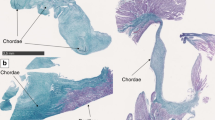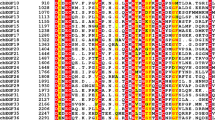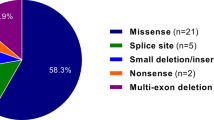Abstract
Geleophysic dysplasia (GD), acromicric dysplasia (AD) and Weill–Marchesani syndrome (WMS) are rare disorders with overlapping characteristics, such as short stature, short hands and feet, joint limitations, skin thickening, mild facial anomalies, normal intelligence and abnormal skeletal symptoms, with GD distinct by progressive cardiac valvular thickening and WMS distinct by microspherophakia and ectopia lentis. Mutations in FBN1 gene have been identified in AD, GD and WMS patients. By targeted next-generation sequencing of skeletal dysplasia-related genes, including FBN1 and ADAMTSL2, three novel missense mutations, c.5189A>T (p.N1730I), c.5198G>T (p.C1733F), c.5243G>T (p.C1748F), and one known mutation c.5198G>A (p.C1733Y) of FBN1 gene were identified in four probands, respectively. Clinically, p.C1733Y was associated with GD, as reported previously, as well as the novel p.N1730I, whereas p.C1733F and p.C1748F were associated with AD and WMS. Interestingly, different mutations at the same codon (p.C1733Y and p.C1733F) were associated with different phenotypes (GD and AD, respectively). However, the mutations p.C1748F and p.C1748R were associated with WMS. Our data support the importance of TGFβ-binding protein-like domain 5 of FBN1 protein in pathogenicity of acromelic dysplasia, and expands the genotype/phenotype relations of these rare forms of fibrilliopathies.
Similar content being viewed by others
Log in or create a free account to read this content
Gain free access to this article, as well as selected content from this journal and more on nature.com
or
References
Faivre, L., Le Merrer, M., Baumann, C., Polak, M., Chatelain, P., Sulmont, V. et al. Acromicric dysplasia: long term outcome and evidence of autosomal dominant inheritance. J. Med. Genet. 38, 745–749 (2001).
Hennekam, R. C., van Bever, Y. & Oorthuys, J. W. Acromicric dysplasia and geleophysic dysplasia: similarities and differences. Eur. J. Pediatr. 155, 311–314 (1996).
Le Goff, C., Morice-Picard, F., Dagoneau, N., Wang, L. W., Perrot, C., Crow, Y. J. et al. ADAMTSL2 mutations in geleophysic dysplasia demonstrate a role for ADAMTS-like proteins in TGF-beta bioavailability regulation. Nat. Genet. 40, 1119–1123 (2008).
Le Goff, C., Mahaut, C., Wang, L. W., Allali, S., Abhyankar, A., Jensen, S. et al. Mutations in the TGFbeta binding-protein-like domain 5 of FBN1 are responsible for acromicric and geleophysic dysplasias. Am. J. Hum. Genet. 89, 7–14 (2011).
Spranger, J. W., Gilbert, E. F., Tuffli, G. A., Rossiter, F. P. & Opitz, J. M. Geleophysic dwarfism—a "focal" mucopolysaccharidosis? Lancet 2, 97–98 (1971).
Scott, A., Yeung, S., Dickinson, D. F., Karbani, G. & Crow, Y. J. Natural history of cardiac involvement in geleophysic dysplasia. Am. J. Med. Genet. A. 132A, 320–323 (2005).
Faivre, L., Dollfus, H., Lyonnet, S., Alembik, Y., Megarbane, A., Samples, J. et al. Clinical homogeneity and genetic heterogeneity in Weill-Marchesani syndrome. Am. J. Med. Genet. A. 123A, 204–207 (2003).
Morales, J., Al-Sharif, L., Khalil, D. S., Shinwari, J. M., Bavi, P., Al-Mahrouqi, R. A. et al. Homozygous mutations in ADAMTS10 and ADAMTS17 cause lenticular myopia, ectopia lentis, glaucoma, spherophakia, and short stature. Am. J. Hum. Genet. 85, 558–568 (2009).
Dietz, H. C., Cutting, G. R., Pyeritz, R. E., Maslen, C. L., Sakai, L. Y., Corson, G. M. et al. Marfan syndrome caused by a recurrent de novo missense mutation in the fibrillin gene. Nature 352, 337–339 (1991).
Cecchi, A., Ogawa, N., Martinez, H. R., Carlson, A., Fan, Y., Penny, D. J. et al. Missense mutations in FBN1 exons 41 and 42 cause Weill-Marchesani syndrome with thoracic aortic disease and Marfan syndrome. Am. J. Med. Genet. A 161, 2305–2310 (2013).
Neptune, E. R., Frischmeyer, P. A., Arking, D. E., Myers, L., Bunton, T. E., Gayraud, B. et al. Dysregulation of TGF-beta activation contributes to pathogenesis in Marfan syndrome. Nat. Genet. 33, 407–411 (2003).
Hubmacher, D. & Apte, S. S. Genetic and functional linkage between ADAMTS superfamily proteins and fibrillin-1: a novel mechanism influencing microfibril assembly and function. Cell Mol. Life Sci. 68, 3137–3148 (2011).
Giray, O., Kyr, M., Bora, E., Saylam, G., Ugurlu, B. & Gurel, D. Clinical and morphological phenotype of geleophysic dysplasia. Ann. Trop. Paediatr. 28, 161–164 (2008).
Lee, T., Takeshima, Y., Okizuka, Y., Hamahira, K., Kusunoki, N., Awano, H. et al. A Japanese child with geleophysic dysplasia caused by a novel mutation of FBN1. Gene 512, 456–459 (2013).
Panagopoulos, P., Fryssira, H., Koutras, I., Daskalakis, G., Economou, A., Benetou, V. et al. Geleophysic dysplasia: a patient with a severe form of the disorder. J. Obstet. Gynaecol. 25, 818–820 (2005).
Titomanlio, L., Della Casa, R., Lecora, M., Farina, V., Sebastio, G., Andria, G. et al. Geleophysic dysplasia: 7-year follow-up study of a patient with an intermediate form. Am. J. Med. Genet. 86, 82–85 (1999).
Faivre, L., Collod-Beroud, G., Loeys, B. L., Child, A., Binquet, C., Gautier, E. et al. Effect of mutation type and location on clinical outcome in 1,013 probands with Marfan syndrome or related phenotypes and FBN1 mutations: an international study. Am. J. Hum. Genet. 81, 454–466 (2007).
Allali, S., Le Goff, C., Pressac-Diebold, I., Pfennig, G., Mahaut, C., Dagoneau, N. et al. Molecular screening of ADAMTSL2 gene in 33 patients reveals the genetic heterogeneity of geleophysic dysplasia. J. Med. Genet. 48, 417–421 (2011).
Pimienta, A. L., Wilcox, W. R. & Reinstein, E. More than meets the eye: The evolving phenotype of Weill-Marchesani syndrome-diagnostic confusion with geleophysic dysplasia. Am. J. Med. Genet. A. 161, 3126–3129 (2013).
Yu, J. & Urban, J. Immunolocalisation of fibrillin microfibrils in the calf metacarpal and vertebral growth plate. J. Anat. 223, 641–650 (2013).
Bax, D. V., Mahalingam, Y., Cain, S., Mellody, K., Freeman, L., Younger, K. et al. Cell adhesion to fibrillin-1: identification of an Arg-Gly-Asp-dependent synergy region and a heparin-binding site that regulates focal adhesion formation. J. Cell. Sci. 120, 1383–1392 (2007).
Cain, S. A., McGovern, A., Baldwin, A. K., Baldock, C. & Kielty, C. M. Fibrillin-1 mutations causing Weill-Marchesani syndrome and acromicric and geleophysic dysplasias disrupt heparan sulfate interactions. PLoS ONE 7, e48634 (2012).
Acknowledgements
This project is supported by NSFC (81071121, 81270936), Shanghai Rising-Star Program (12QH1401800), Shanghai Health Bureau (2012112), Major Program of Shanghai Committee of Science and Technology (11dz195030), National Key Technology R&D Program (2012BAI09B04).These funds have no role in study design, or collection, analysis, interpretation of data, or in decision to submit the article for publication.
Author information
Authors and Affiliations
Corresponding authors
Ethics declarations
Competing interests
The authors declare no conflict of interest.
Additional information
Supplementary Information accompanies the paper on Journal of Human Genetics website
Supplementary information
Rights and permissions
About this article
Cite this article
Wang, Y., Zhang, H., Ye, J. et al. Three novel mutations of the FBN1 gene in Chinese children with acromelic dysplasia. J Hum Genet 59, 563–567 (2014). https://doi.org/10.1038/jhg.2014.73
Received:
Revised:
Accepted:
Published:
Issue date:
DOI: https://doi.org/10.1038/jhg.2014.73
This article is cited by
-
A pilot study of gene testing of genetic bone dysplasia using targeted next-generation sequencing
Journal of Human Genetics (2015)



